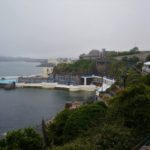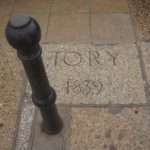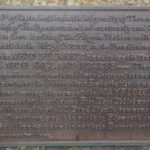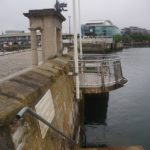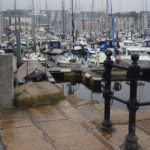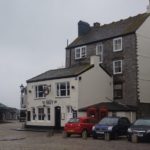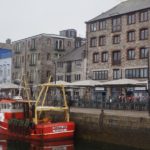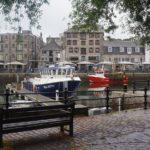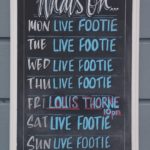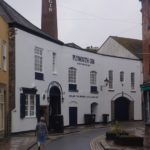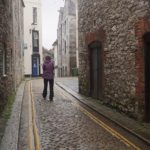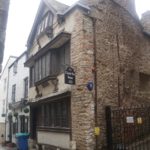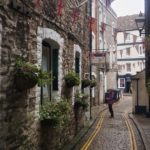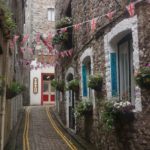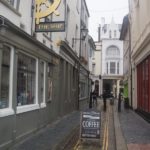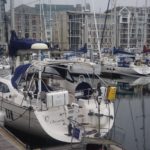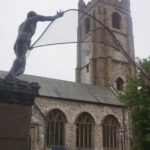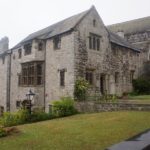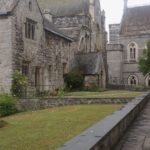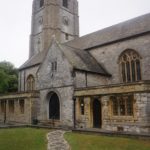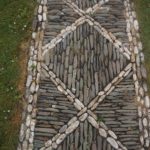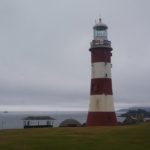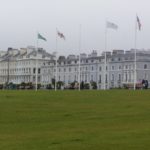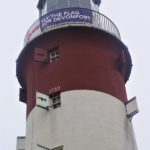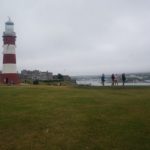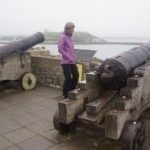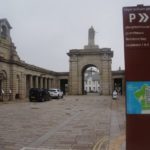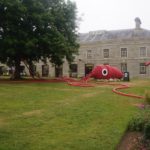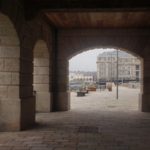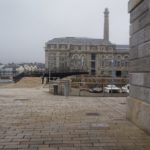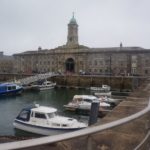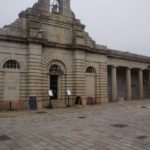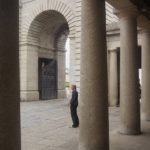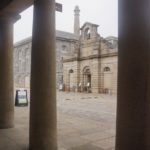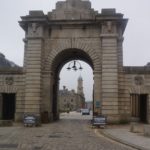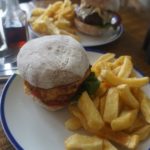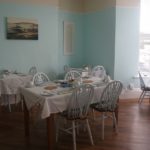A quiet day wandering around the historic city of Plymouth. Although highly recommended we didn’t get to the Plymouth Gin Distillery.
We made our way to the Mayflower Steps to ‘officially’ complete our walk. I reckon the finish should be at the Cremyll ferry where you ‘officially’ move form Cornwall into Devon.
The Mayflower Steps are a bit of an anti-climax. There is a memorial but the causeway of 1620 was destroyed long, long ago and the present steps are only from the 1890s. Amazingly we were the only ones there. No coach loads of American tourists, just two Kiwi tourists admiring a far more important memorial. This same quay is where the New Zealand barque Tory set sail in May 1839 for Port Nicholson, now Wellington, to start the settlement of New Zealand.
We had a look around Barbican. Barbican is the ‘old town’ area around Sutton Harbour, the original harbour of Plymouth. It is one of the few parts of the city to escape destruction during the bombing of WW2. A few of the streets and alleys still have the character of an old fishing port. It is said to have the highest concentration of cobbled streets in England.
In the afternoon we walked back to Stonehouse (where the Cremyll ferry dropped us yesterday) and had a look around Royal William Yard. This is a huge complex that was the major victualling depot for the Royal Navy. It was built in 1826 – 1835 and is named after King William IV. It had slaughterhouses, bakeries, a brewery, a biscuit factory, coopers for making barrels and vast storehouses for food, clothing and equipment. The navy moved out in 1993 and now it is a mixed-use development of residences, restaurants, cafes, shops, a marina, a ferry terminal, etc. It was all looking very quiet and empty while we were there.
We also visited The Hoe. This is a green expanse on a hill that separates the city of Plymouth from the sea. It is most famous for being the site of Francis Drake’s game of bowls in 1588. With the Spanish Armada fast approaching he resolved to finish his game and wait for the tide to turn before engaging with the enemy. There are a lot of other memorials and statues on the green including Smeaton’s Tower. Originally the third lighthouse to be put on Eddystone Rocks ( 14 km southwest of Rame Head where we were at the chapel yesterday), it was dismantled in 1882 and the upper portions rebuilt on The Hoe. Smeaton was the original builder of the tower in 1759.
Tomorrow we catch the train back to London. What a shock that will be. The thing we loved most about the South West Coastal Path was its quietness, remoteness and isolation.
For those who are interested: Plymouth lies on two rivers, the Tamar and the Plym, hence its name, the mouth of the Plym.
- Tinside Lido saltwater pool and Smeaton’s Tower
- This tablet commemorates the departure from Plymouth in May 1839 of the ‘Tory’, the pioneer ship in the colonisation of New Zealand
- Tory Memorial
- Mayflower Steps Memorial
- About the Mayflower and steps
- Mayflower Steps Memorial
- Sutton Harbour, Plymouth
- Barbican, Plymouth
- Quay Rd, Barbican, Plymouth
- Barbican, Plymouth
- Tough luck if you don’t like World Cup Football
- Where Plymouth Gin comes from
- Barbican, Plymouth
- Elizabethan Gardens, Barbican, Plymouth
- Elizabethan Gardens, Barbican, Plymouth
- Papa Singer, mama Singer and baby Singer
- 16th century house, Barbican, Plymouth
- Narrow streets of Barbican
- Narrow streets of Barbican
- Narrow streets of Barbican
- Park your yacht outside your apartment, Sutton Harbour, Plymouth
- Minster Church of St Andrew, Plymouth
- The oldest house in Plymouth, 15th century
- The Abbey, Plymouth
- Minster Church of St Andrew, Plymouth
- Nice stone paving
- Devonshire Tea now we are in Devon, no longer Cornish Cream Tea
- Sir Francis Drake
- Smeaton’s Tower, 72 ft restored Eddystone Lighthouse
- Terrace Houses, Hoe Promenade, Plymouth
- Smeaton’s Tower
- Smeaton’s Tower, The Hoe, Plymouth
- 18 pounder and a 24 pounder, Plymouth
- Royal William Yard
- Royal William Yard. This might be something the Navy left behind.
- Royal William Yard
- Royal William Yard
- Royal William Yard
- Royal William Yard
- Royal William Yard
- Royal William Yard. Barbara is very patient
- Royal William Yard
- Royal William Yard
- We had a resolution – no more burgers. But when you’re really hungry!
- The dining room, Sea Breezes Guesthouse, Plymouth

